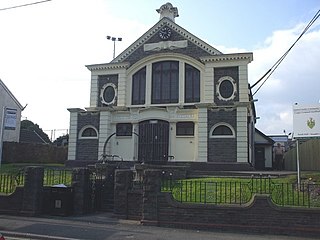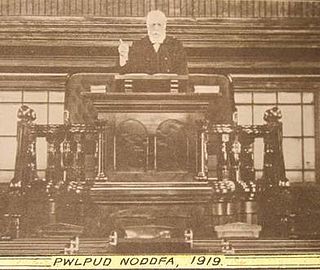
Llwynhendy, is a village and ward near the town of Llanelli in Carmarthenshire, Wales. The ward, which includes the village, as well as Cefncaeau, parts of Cwmcarnhywel and parts of Bryn and Penceilogi, had a population of 4,276.

Llanllyfni is a village and a community in Gwynedd, Wales. It is in the historic county of Caernarfonshire. The community consists of the villages of Drws-y-coed, Nantlle, Nasareth, Nebo, Penygroes, Talysarn and the village of Llanllyfni itself. Penygroes, Llanllyfni and Talysarn are almost conjoined. As an electoral ward the 2011 census recorded a population of 1256. It is a largely Welsh-speaking village as 85% of the villagers speak Welsh as their first language. The community covers 43 square kilometres.
The London Welsh School is a Welsh medium primary school in London, England. Welsh is the language predominantly used for all classes and activities. The school offers a bilingual education to children aged four to 11. The school also has a pre-school class for three and four-year-old children, and a baby and toddler group called Miri Mawr that meets on Friday mornings.

Church Village is a large village in the historic parish and community of Llantwit Fardre, located within the Taff Ely district of the County Borough of Rhondda Cynon Taf in Wales. The village is centrally located being around 4 miles (6.4 km) from the local principal towns of Llantrisant to the southwest and Pontypridd to the north and is situated around 10 miles (16 km) northwest of Cardiff city centre.

Canolfan Soar is a Grade II-listed community facility in Merthyr Tydfil, Wales, that includes a theatre and other facilities. It was converted from the closed Grade II-listed, eighteenth-century, Zoar Chapel in the first decade of the twenty-first century.

In the United Kingdom, the term listed building refers to a building or other structure officially designated as being of special architectural, historical, or cultural significance; Grade II* structures are those considered to be "particularly important buildings of more than special interest". Listing was begun by a provision in the Town and Country Planning Act 1947. Once listed, strict limitations are imposed on the modifications allowed to a building's structure or fittings. In Wales, the authority for listing under the Planning Act 1990 rests with Cadw.

Calfaria Baptist Chapel, Aberdare, was one of the largest baptist churches in the South Wales Valleys and the oldest in the Aberdare valley. The chapel had an ornate interior, including a boarded ceiling with a deeply undercut rose, while the balcony balustrading had a cast iron front with an intricate foliage design. These features were common in the Welsh chapels of the late nineteenth century. The organ was installed in 1903 at a cost of £850. It was played for the last time in 2012 by Robert Nicholls, during a Radio Cymru broadcast shortly before the closure of the chapel.

The Jewin Welsh Presbyterian Chapel is a Presbyterian Church of Wales church in Clerkenwell, London, England.

Noddfa or Noddfa Welsh Baptist Chapel, was located in Treorchy in the Rhondda Valley. It was one of the largest Baptist churches in the South Wales valleys, and one of the largest and grandest of all Welsh chapels.

Bethel, Abernant is a Baptist Chapel at Abernant in the Aberdare Valley in Wales and one of the few nonconformist chapels in the area that remained open into the twenty-first century.
Heolyfelin Chapel, Trecynon, Aberdare was a Welsh Baptist chapel established in 1855. Services were held in the Welsh language. The building seated 800. By December 2015 the chapel had closed and was for sale.
Gwawr, Aberaman was a Baptist chapel in Regent Street, Aberaman, near Aberdare, South Wales, formed as a branch of Calfaria, Aberdare
Seion, Cwmaman is a Welsh Baptist church, originally established in 1859. The chapel closed in 2013 but the church still meets at another location in the village.
Jerusalem, Penrhiwceiber was a Baptist chapel in Penrhiwceiber, Glamorgan, Wales. Services at Jerusalem were conducted in the Welsh language.

Thomas Thomas was a Welsh church minister and chapel architect, also known as Thomas Glandŵr. He is described as "the first national architect of Wales" and the "unchallenged master of chapel architecture in Wales in the 1860s".

Bethesda, Abercwmboi is a Welsh Baptist church in Abercwmboi near Aberdare, South Wales. Services continue to be held in the Welsh language.

Gellionnen Chapel is a Unitarian place of worship near Pontardawe, South Wales, United Kingdom. The chapel was first built in 1692 by Protestant dissenters, becoming Unitarian in the late 18th century. It is a member of the General Assembly of Unitarian and Free Christian Churches, the umbrella body for British Unitarians. Gellionnen Chapel is the oldest Dissenting chapel in the Swansea Valley, is one of the oldest surviving chapels in the region and is a Grade II* listed building.
Bethania, Cwmbach was a Baptist Chapel at Cwmbach in the Aberdare Valley in Wales. Badly damaged by an air raid attack in 1941 it was subsequently restored but closed in the 1980s. Services were held in the Welsh language.
Rhos, Mountain Ash was a Baptist chapel in Mountain Ash, Glamorgan, Wales. Services at Rhos were conducted in the Welsh language.













